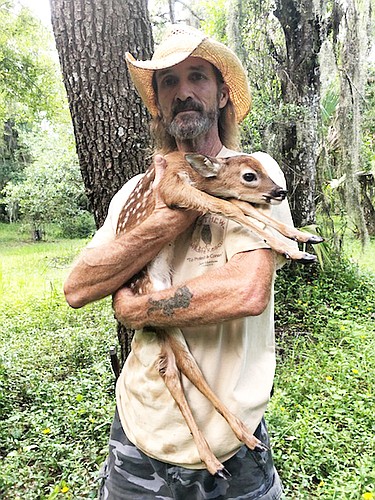- April 19, 2024
-
-
Loading

Loading

On any give day, Debbie Goss and other staff members of Lakewood Ranch Town Hall’s Operations Department field phone calls about broken sprinkler heads, dead trees, algae-filled ponds or other maintenance issues.
But each spring, they handle yet another type of call — about fawns. Spring is birthing season.
“There are so many deer in Lakewood Ranch,” said Goss, office manager for the operations department. “Just like with the alligators, people are going to see the fawns. Unless they look distressed or are crying or are off wandering around, don’t (worry). If they’re hidden and they’re sleeping, that’s what they’re supposed to be doing.”
Wildlife rehabilitator Justin Matthews, of Justin Matthews Wildlife Rescue, rescued an emaciated fawn from Greenbrook about two weeks ago. Upon meeting with a worried citizen and talking with neighbors, Matthews learned the mother deer had, for many years, lost use of one hind leg. This season, she birthed twins.
Matthews saw the mother with one healthy baby walking beside her, but the other was left unattended and had become emaciated. The doe was unable to care for both fawns, Matthew said, and he took the sickly fawn to Wildlife Inc., on Anna Maria Island. The nonprofit has property to rehabilitate deer elsewhere in the state.
Normally, however, fawns are OK. People believe they’ve been abandoned by their mothers, but Matthews said it usually isn’t true. Deer leave their young near homes to keep them safe from prey as they forage during the daytime.
“Most people when they see one alone, they think it’s abandoned and that’s not the case,” Matthews said. “The fawns will stay perfectly still like a statue. Mom comes back and it follows mom. They never leave it in the same spot for a couple days.”
Most of the time when a concerned citizen calls, Matthews checks it out. If the fawn looks healthy, he tells the citizen to wait until nightfall and “you’ll see something cute.” They normally call back amazed from watching the fawn frolic upon seeing its mother.
But if the fawn is there more than one night, it’s time to call a wildlife rescuer to check it out.
“If they see them one day, leave him where he is,” Matthews said. “If in same spot, call me. There’s something wrong.”
Goss also said it’s important to keep deer from being imprinted. She was mauled by a 7-point buck in her neighborhood in Arcadia two years ago. He was raised by people, and even wore an orange collar. The deer attacked her during mating season while she was in her backyard.
“When you handle them, they lose their fear of humans,” Goss said. “That’s what makes them more aggressive. Same thing with gators, with residents feeding them.”
Goss said it’s important for residents to leave the fawns alone. If they are worried, they should contact a local wildlife rehabilitator rather than taking action themselves. Last year, a fawn died in GreyHawk Landing because of human intervention.
Matthews said it’s important for residents to leave the fawns alone and contact professionals if they are concerned. Fawns have no scent when they are born, which helps them from being discovered by predators.
Matthews can be reached at 822-3272.